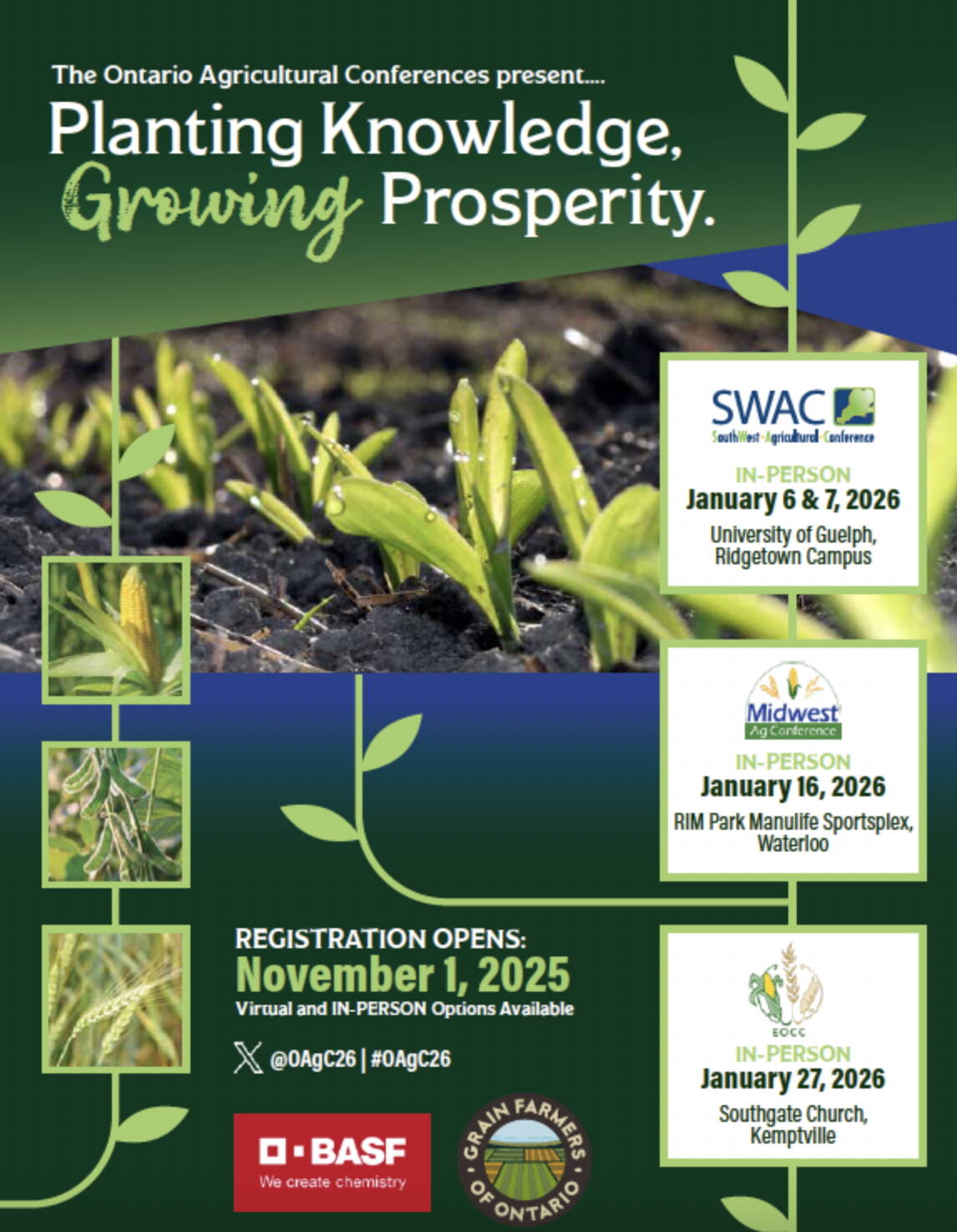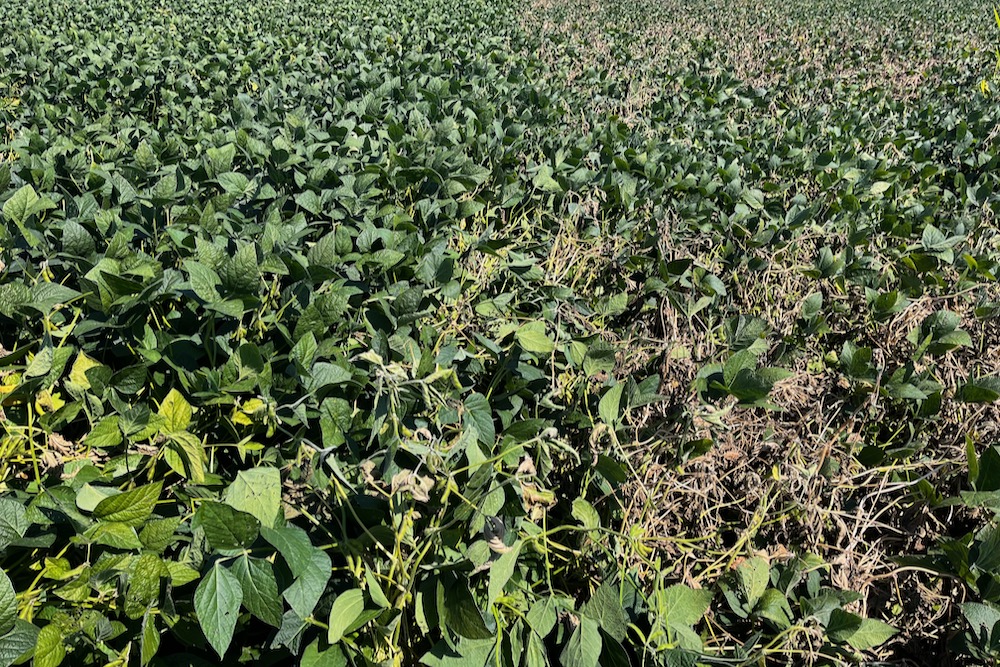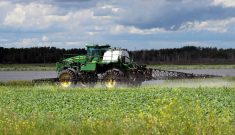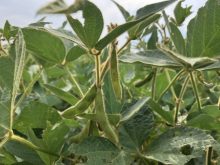Wet and warm summer weather brings two things to southwestern Ontario: mosquitoes and disease pressure. Both were abundant during an early September Pioneer soybean plot tour in Essex County.
For Emma Epp, certified crop advisor, co-owner of Epp Ag Solutions near Leamington, and host of the plot tour, the main enemy in 2023 has been white mould.
The fungus is particularly proficient at robbing yields and thrives when conditions are moist and crops are lush.
Read Also

Ontario Agricultural Conference increases accessibility
The Ontario Agricultural Conference 2026 offers in-person and online access to expert insights, hands-on learning, and networking opportunities.
Why it matters: In sufficient quantity, white mould can be a devastating disease in both dry beans and soybeans.
“Typically, we only see it on the sand, but you can see it on the clay ground this year,” says Epp, noting white mould appears to have infected all of her soybean plots to some degree.
“It’s in all of them. I think the rain in itself was the reason it exploded.”
Observations like Epp’s occurred in other parts of the province, too. In the Dundalk area, Deb Campbell, agronomist and owner of Agronomy Advantage, says white mould has hit both soybeans and dry beans, especially the latter.
“The cool wet conditions in mid-July were ideal for white mould infection,” says Campbell. “The dense early patches affected by mould will see significant yield loss, upwards of 20-plus bushels. Fungicides have performed well for the most part and mould impact in sprayed fields will be less than five-bushel loss range.”
White mould is not widespread, or at least not as widespread as predicted, given wet weather. According to Russ Barker, Pioneer Hybrid sales representative and agronomist based in St. Mary’s, this is partially a result of proactive fungicide applications earlier in the summer. The most severe cases are in unsprayed fields planted to varieties with weak tolerance.
“Varieties that have excellent white mould tolerance are clean. Genetic selection continues to be our best defence against white mould, year in and year out,” says Barker.
Barker agrees that the edible bean situation is much worse. Where stands are lush, white mould has been a significant challenge. Repeated applications of fungicide have not held it in check.
“It is much too late for additional steps to control white mould, or any other disease, for that matter. The biggest yield drag on all beans will be poor internal farm drainage, which leads to a host of root rot problems and poor yields,” Barker says.
Chemical controls are best used before the pathogen can infect blossoms.
“A bigger concern is harvest of all beans is delayed. It has been too cool to really drive maturity to the finish. We are seven to 14 days behind where we would like to be from a maturity standpoint. That being said, numerous fields of soybeans are turning colour so we remain hopeful for a good harvest.”
Horst Bohner, soybean specialist with the Ontario Ministry of Agriculture, Food and Rural Affairs, reiterates that white mould is mostly an individual field problem, despite being more widespread. Eastern Ontario has more fields with significant problems, some of which he classified as “devastated.”
“In much of south and central Ontario there is little white mould. In fact, I am happy we don’t have a lot more, considering the cool and wet August we had.
“I think it was not as bad for some because things were actually dry early during flowering and then excessive rainfall drowned some of the sclerotia in my area,” says Bohner.
“There are large variety differences and field management practice differences. No-till fields have less white mould and fields that were sprayed twice have less. Having said that, both still had some white mould.
“Overall, this is a year to take note of which fields have white mould to plan for future years to make good management practices.”
Speaking after her September event, Epp encouraged growers to document areas where white mould has been a problem and make plans to apply fungicide next year. Bohner says the same.
Next steps
Other control strategies can help. As described by Bohner is a 2022 Field Crop News article, refraining from tilling fields with high white mould pressure can reduce the inoculum (sclerotia) load in the following year.

“A large percentage of sclerotia will naturally die if left on the soil surface. This means that fields with significant amounts of white mould should not be tilled after harvest. In addition, no-till soybean growers will also have less white mould because more of the sclerotia die off on the surface during the spring and early summer.
“No-till soybeans also have less vigorous growth, so the canopy is less rank, shorter in stature and maintains lower relative humidity,” Bohner says.
“The most effective way to reduce the inoculum load in a field is to grow fewer susceptible crops in the rotation. The more years between susceptible crops like soybeans, edible beans and canola, the less disease pressure there will be.”
Planting less susceptible crop varieties also helps prevent white mould problems and inoculum buildup.
“There are multiple genes that provide some level of resistance and many soybean breeding programs are now attempting to include more of these traits,” says Bohner.
“Seed companies often provide white mould ratings, but it must be noted that there is no standardized rating system. This means the scores can only be used as a general guide and are not always reliable.
“Soybeans planted very early (late April) sometimes have less white mould. This is largely because the plants are physically shorter than those planted in the middle of May, and the beans may finish flowering before late August rains.”
Bohner concludes that reduced soybean planting rates can improve white mould control, since fewer plants create a less dense canopy and hopefully a drier soil surface. Trials in Michigan, for example, show reduced seeding rates in areas with white mould can lead to higher yields.
“All row widths, including wide rows, get white mould. Planting in 30-inch rows has been deemed a good practice for fields with a history of severe white mould pressure, especially in areas that have sufficient [heat units] or soil types to close the canopy by R3,” says Bohner.
“Short season areas may be better to stick with 15-inch rows or they will give up too much yield, especially if planting is delayed. The overall plant population is what matters, not so much the row spacing. Fields with a history of high white mould pressure should aim for a final plant stand of approximately 80,000 to 100,000 plants per acre in 30-inch rows based on these Michigan trials.”















